Best Vitamin D Drops for Baby – Dietitian’s Top Picks
Jan 19, 2022, Updated Jun 11, 2025
This post contains affiliate links. Please see our disclosure policy.
Best Vitamin D Drops for baby
Pediatricians recommend vitamin D drops for baby because vitamin D plays several major roles in the body. Vitamin D is an important vitamin that helps build strong bones, promote muscle development, and supports a strong immune system.
A deficiency of vitamin D is a problem for babies and young children. A deficiency can disrupt the balance of other important nutrients in the body like calcium and phosphorus. It can also delay proper growth and bone development. Low levels of vitamin D contribute to bone-softening conditions like rickets. Because of this, it is important to make sure little ones are getting enough vitamin D from the start.
Note: this post contains affiliate links. As an Amazon Associate, I earn from qualifying purchases at no extra cost to you.
How much vitamin D does my baby need?
The American Academy of Pediatrics (in the United States) recommends that babies under 12 months of age take 400 IU vitamin D daily. IU stands for international units. You may also see vitamin D measured in micrograms, mcg. 10 mcg is 400 IU.
This recommendation was primarily put into place to prevent rickets. Breastfed babies won’t hit this mark from breast milk alone, so a supplement is usually recommended. Formula-fed infants do not generally need to supplement additional vitamin D as infant formulas are fortified with the required amount.
In the second year of life, toddlers need 600 IU of vitamin D daily. They will likely get this amount from a combination of sources, including vitamin D fortified milk. I also have toddler vitamin D drop recommendations below if they don’t have milk or foods with vitamin D daily.
Types of Vitamin D
There are 2 versions of vitamin D we commonly see in foods and supplements. Vitamin D2, also called ergocalciferol, and vitamin D3, called cholecalciferol. Vitamin D2 usually comes from plant sources and vitamin D3 is found in mostly animal sources. The gold standard is Vitamin D3 because it is more easily absorbed by the body. Vitamin D3, cholecalciferol, is more effective at raising blood levels of vitamin D.
Ways to get Vitamin D
Food
Once your baby starts eating solid foods, they will likely get some vitamin D from the foods they eat. But there aren’t many foods high in vitamin D. So, reaching the goal intake may require a combination of food, drink, and supplements. And as mentioned before, infant formula does contain vitamin D, so formula-fed babies don’t require vitamin D supplementation until they stop formula.
Salmon, mushrooms, egg yolk, and fortified drinks like cow’s milk and orange juice do contain vitamin D. Incorporating these foods into your baby’s diet help boost their vitamin D intake. For example, an ounce of cooked salmon has about 150 IU vitamin D3, and one cup of fortified orange juice contains about 100 IU.
Certain other foods like some cereals, oatmeal, and alternative milks may also be fortified with vitamin D.
Sunlight
Vitamin D is the sunshine vitamin! Bodies produce vitamin D from exposure to direct sunlight, and you can spend some time in the sun with your little one. However, we know too much sun exposure has negative effects on the skin. Babies should generally be kept out of the sun in the first 6 months of life. Protect 6 months+ babies with sunscreen. However, this will inhibit the skin’s absorption of vitamin D from direct sunlight. That’s okay, since they can get vitamin D elsewhere.
Also, it’s difficult to exactly quantify how much vitamin D your baby’s skin absorbs from sun exposure. This is because different skin tones absorb it at different rates. Darker skin tones require longer exposure to soak up vitamin D than lighter skin tones.
The safest time to spend in the sun is in the morning when UV index is not as high, and risk of sunburn is minimal. It’s also a good idea to cap exposure time to make sure their sensitive skin is protected.
I wouldn’t recommend relying on sunshine alone to meet baby’s needs (or toddler’s needs) for vitamin D.
Supplements
Baby vitamin D drops are the most commonly used supplement to ensure your baby gets their daily dose of vitamin D. Ways to administer vitamin D drops include:
- Drop directly into baby’s mouth
- Add them to baby’s bottle/cup
- Apply a drop to the nipple if breastfeeding.
There are also a few sprays on the market if that is easier for your baby to take.
These supplements are usually in D3 form, the form most easily absorbed by the body. They are either flavorless or formulated without artificial flavors. The liquid versions are usually vitamin D in a medium chain triglyceride base oil, like coconut oil or olive oil. Either one would be fine for baby. They are basically tasteless drops so flavor should not be a problem.
Let’s take a look at some of the best vitamin D supplements. All of these supplements will meet your baby or toddler’s needs for daily vitamin D intake with their corresponding serving sizes. I prefer the brands that the dose is a single drop because it’s the easiest thing, in my opinion! There is no “best one,” all of these are great options. I would choose whichever brand you prefer or the one that is easiest to get.
Pediatricians often recommend Enfamil D-Vi-Sol, but it’s not my favorite. It contain glycerin (a sugar alcohol), and I much prefer the vitamin D3 in medium chain triglyceride fat formulations. See below for my picks!
Daily Vitamin D Supplement Recommendations for Baby
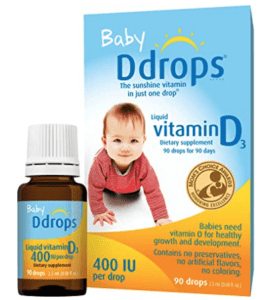
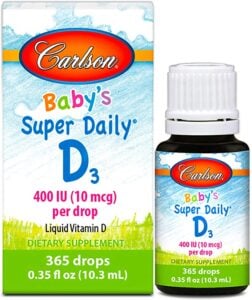
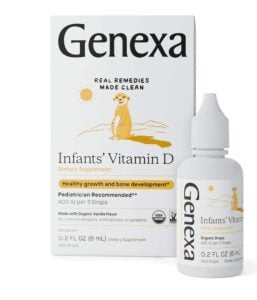
Nordic Naturals Baby’s Vitamin D3

Mary Ruth’s Vegan Vitamin D3 Liquid Spray

Vitamin D supplements for Toddlers
Even though they may still feel like a baby at 12 months, this is the official age they become a toddler! Vitamin D supplement guidelines suggest a dose of 600 IU, an increase from the 400 IU recommendation for babies.
If they drink milk with vitamin D added, you can continue with the baby dose. They will get enough extra in their milk to make up the difference. If they don’t like milk, or drink one without vitamin D added, consider switching to one of the below.
Ddrops Booster Liquid D3 600 IU

Mary Ruth’s Vegan Vitamin D3 +K2 Liquid Spray
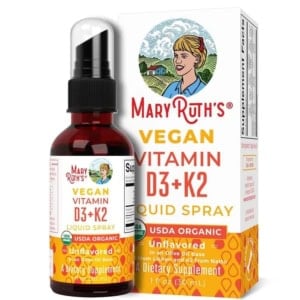
Mary Ruth’s Toddler Plant Based Vitamin D3 + K2 Liquid Drops

Note on Vitamin Drops
Check in with your pediatrician for any questions related specifically to your child. This post is for information only. For recommended dosage or questions about your baby’s health, please speak to their health care provider.
You Might Also Be Interested In
The Best Probiotic Foods for Kids
Food for Sick Toddlers: What to do when they won’t eat!
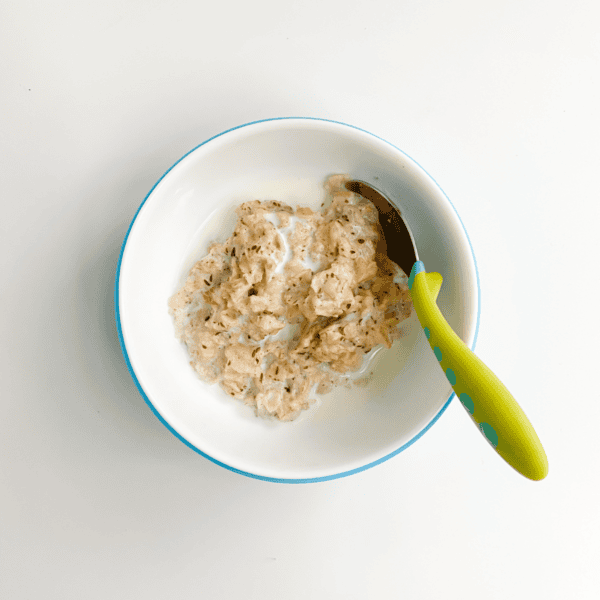













Hey there! Just wanted to let you know your Mary Ruth product links for the toddlers are broken. It takes you to a Share a Sale error page.